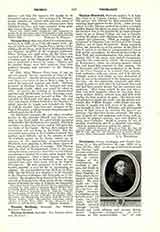

Thomas Percy, BLESSED, Earl of Northumberland, martyr, b. in 1528; d. at York, August 22, 1572. He was the eldest son of Sir Thomas Percy, brother of the childless Henry Percy, sixth Earl of Northumberland, and Eleanor, daughter of Sir Guiscard Harbottal. When Thomas was eight years old his father was executed at Tyburn (June 2, 1537) for having taken a leading part in the Pilgrimage of Grace, and he also is considered a martyr by many. Thomas and his brother Henry were then removed from their mother’s keeping and entrusted to Sir Thomas Tempest.
In 1549, when Thomas Percy came of age, an Act was passed “for the restitution in blood of Mr. Thomas Percy”. Shortly afterwards he was knighted, and, three years later, in Queen Mary’s reign, he regained his ancestral honors and lands. Declared governor of Prudhoe Castle he besieged and took Scarborough Castle, which was seized by rebels in 1557. In reward the Earldom of Northumberland together with the Baronies of Percy, Poynings, Lucy, Bryan, and Fitzpane were restored to him. He was installed at Whitehall with great pomp, and soon after was named Warden General of the Marches, in which capacity he fought and defeated the Scots. In 1558 he married Anne Somerset, daughter of the Earl of Worcester, a valiant woman who subsequently suffered much for the Faith.
On Elizabeth‘s accession the earl, whose steadfast loyalty to the Catholic Church was known, was kept in the North while the anti-Catholic measures of Elizabeth‘s first Parliament were passed. Elizabeth continued to show him favor, and in 1563 gave him the Order of the Garter. He had then resigned the wardenship and was living in the South. But the systematic persecution of the Catholics rendered their position most difficult, and in the autumn of 1569 the Catholic gentry in the North, stirred up by rumors of the approaching excommunication of Elizabeth, were planning to liberate Mary, Queen of Scots, and obtain liberty of worship. Earl Thomas with the Earl of Westmoreland wrote to the pope asking for advice, but before their letter reached Rome circumstances hurried them into action against their better judgment. After a brief success the rising failed, and Thomas fled to Scotland, where he was captured and, after three years, sold to the English Government. He was conducted to York and beheaded, refusing to save his life by abandoning his religion. He was beatified by Leo XIII on May 13, 1895, and his festival was appointed to be observed in the Dioceses of Hexham and Newcastle on November 14. His daughter Mary founded the Benedictine convent at Brussels from which nearly all the existing houses of Benedictine nuns in England are descended.
EDWIN BURTON

